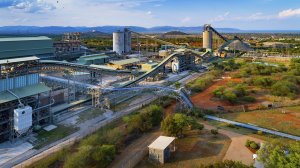JOHANNESBURG (miningweekly.com) – Platinum group metals (PGMs) mining company Royal Bafokeng Platinum (RBPlat) which on Tuesday reported a record performance accompanied by a R1.5-billion maiden dividend payment, is conducting a study into the economic feasibility of building a 30 MW modular photovoltaic (PV) solar energy plant at the BRPM mine.
During question time in which Mining Weekly took part, RBPlat executive head of operations Neil Carr reported that RBPlat intended to conclude the feasibility study towards the end of this year and early 2022. (Also watch attached Creamer Media video.)
Carr said that the project would be tackled from an environmental point of view and would aim to limit RBPlat’s exposure to power utility Eskom and to take the peak off daily Eskom power demand.
“It’s an exciting project in our world and we hope that the feasibility will show some positive results as we progress it during the course of this year,” Carr added.
Earlier, RBPlat CEO Steve Phiri said that the company is investigating green energy alternatives across a broad front.
“We support all the Sustainable Development Goals and have prioritised them based on what we believe our contribution should be,” said Phiri.
“We’ve adopted the precautionary approach to environmental management that is based on best practice, legal compliance and maintaining our environmental and social licence to operate.
“We are starting to see some green shoots as the fundamentals for platinum remain good and particularly in China, where additional demand for larger diesel-based vehicles is improving.
“We are told that some substitution from palladium to platinum is happening, albeit quietly. But certainly the future of platinum is in the hydrogen economy and we are excited about that,” Phiri said.
RBPlat’s environmental management systems are aligned and certified under ISO 14 001 requirements and the company voluntarily participates in the carbon disclosure project, which allows it to benchmark and measure its progress towards environmental stewardship.
“Addressing the impact of climate change remains our key focus, with ongoing climate risk and vulnerability studies being conducted in our operations,” Phiri said.
The company has set itself energy and water efficiency targets with the aim of lowering consumption of water, fuel and electricity.
“We’re in the process of updating our energy and water strategies to identify more energy and water savings opportunities,” said Phiri.
TRANSITIONING TO LOW CARBON
The PGMs mined by the black-controlled, black-led and black-managed RBPlat – which is celebrating its tenth anniversary of being listed on the JSE with 278%-higher earnings to R6.6-billion for the 12 months to the end of December on 79%-higher revenue of R13.4-billion – play a significant role in enabling the transition of the world to a low-carbon economy.
On current market demand, Phiri said: “Whilst not understating competition from battery electric vehicles, the strong automotive demand for rhodium and palladium is expected to continue as a result of the stringent anti-emissions legislation in the major economies.”
Last year was characterised by a significant improvement in the PGMs market, a weaker South African rand and strong operational performance resulting in record production with a year-on-year increase in tonnes hoisted of 9.2% to 4 140 000 t, a 3.7% increase in tonnes milled to 3 990 000 t, and a 4.5% increase in 4E metals in concentrate to 419 000 oz.
Merensky tonnes hoisted increased by 4.7% to 3 335 000 t in line with the increased contribution from Styldrift. Upper group two (UG2) tonnes hoisted increased by 32.6% to 805 000 t, as the transition to UG2 at South shaft gained traction.
The increased Styldrift volumes offset the impact of the Covid shutdown on BRPM production and declining South shaft Merensky reserves.
Styldrift built-up head grade increased by 3.2% to 3.89 g/t 4E whilst BRPM head grade reduced marginally by 1.0% to 3.97 g/t 4E. The reduction in the BRPM head grade is attributable to a higher off-reef dilution on the South shaft Merensky due to geological complexity experienced in current mining areas and the increased contribution of lower grade South shaft UG2 to the overall ore mix.
Cash operating costs for the business increased by R838-million, or 14.8%, year-on-year to R6 513-million compared with 2019, which was attributable to higher production volumes, industry inflation and additional Covid pandemic management costs. Also included is R900-million of operating costs expensed during the managed shutdown and ramp-up of operations, resulting from the national lockdown.
Cash unit costs per tonne milled increased by 10.6% to R1 632 and 4E ounce tonnes milled by 10.1% to R15 560, mainly owing to an increase in surface stocks, together with the impact of the national lockdown on production and Covid-related costs.
IRIDIUM TRADING AT ALL-TIME HIGHS
Asked by an analyst whether RBPlat received full value for iridium PGM metal on the same basis as the major PGMs, RBPlat CFO Hanré Rossouw responded that RBPlat had not disclosed this in the past and that he could not comment.
Iridium has been trading at all-time highs of $5 000/oz with prices having more than doubled since December, Goldman Sachs Equity Research reported in a note on Tuesday. Quoting Platts, the equity research unit stated that iridium’s latest price rally was driven by supply shortages from South Africa, which accounts for 81% of global iridium mine supply.
Another key reason is the demand for iridium from a fifth generation telecommunications perspective, with the Goldman Sachs Equity Research note pointing out that iridium is a critical element in several niche products used for electronics and telecommunications systems. It is also used in proton electron membrane, or PEM, electrolysers in the production of green hydrogen by electrolysis.
EMAIL THIS ARTICLE SAVE THIS ARTICLE ARTICLE ENQUIRY
To subscribe email subscriptions@creamermedia.co.za or click here
To advertise email advertising@creamermedia.co.za or click here










